Account by Maj William Sochon on operation Semut III
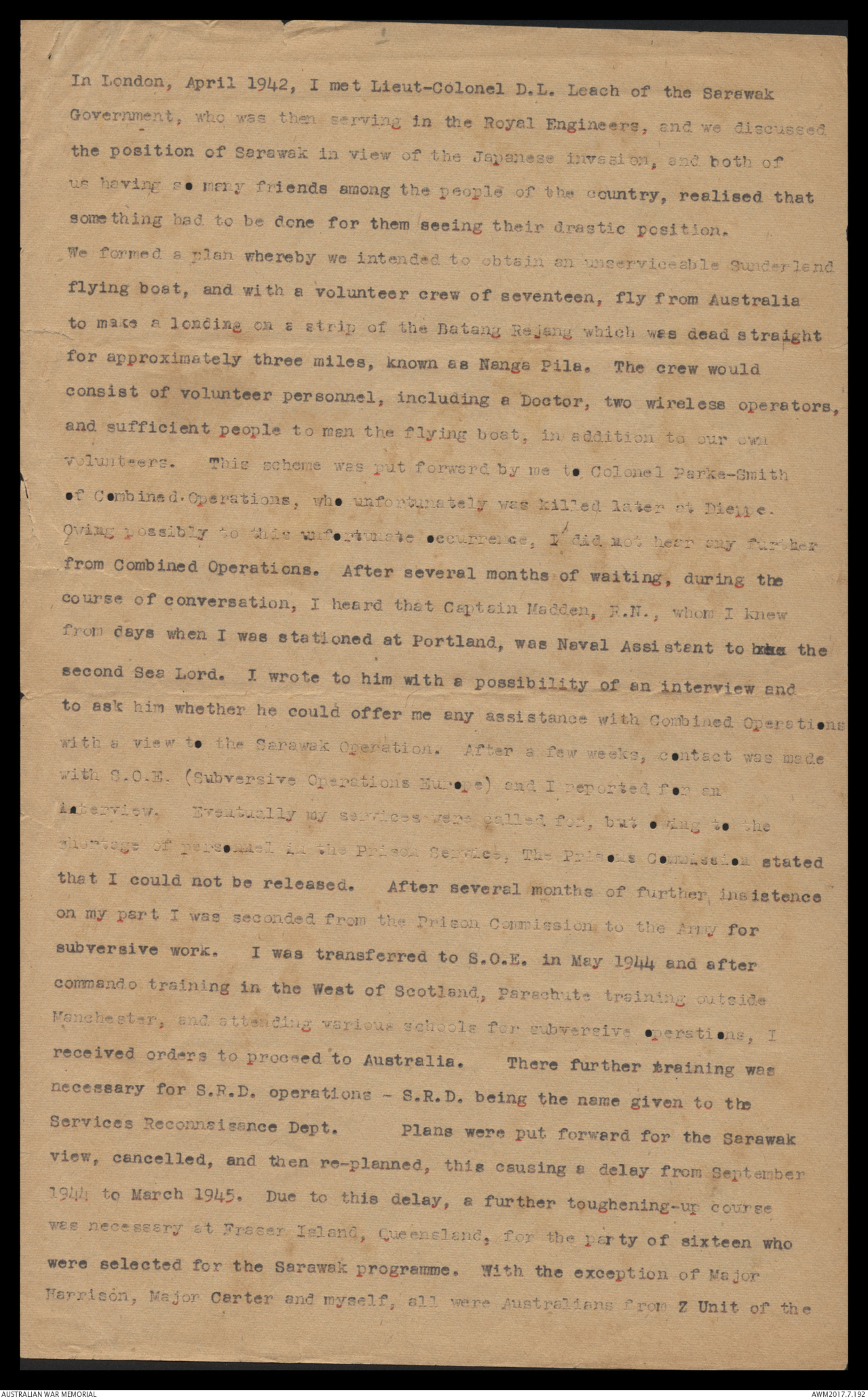
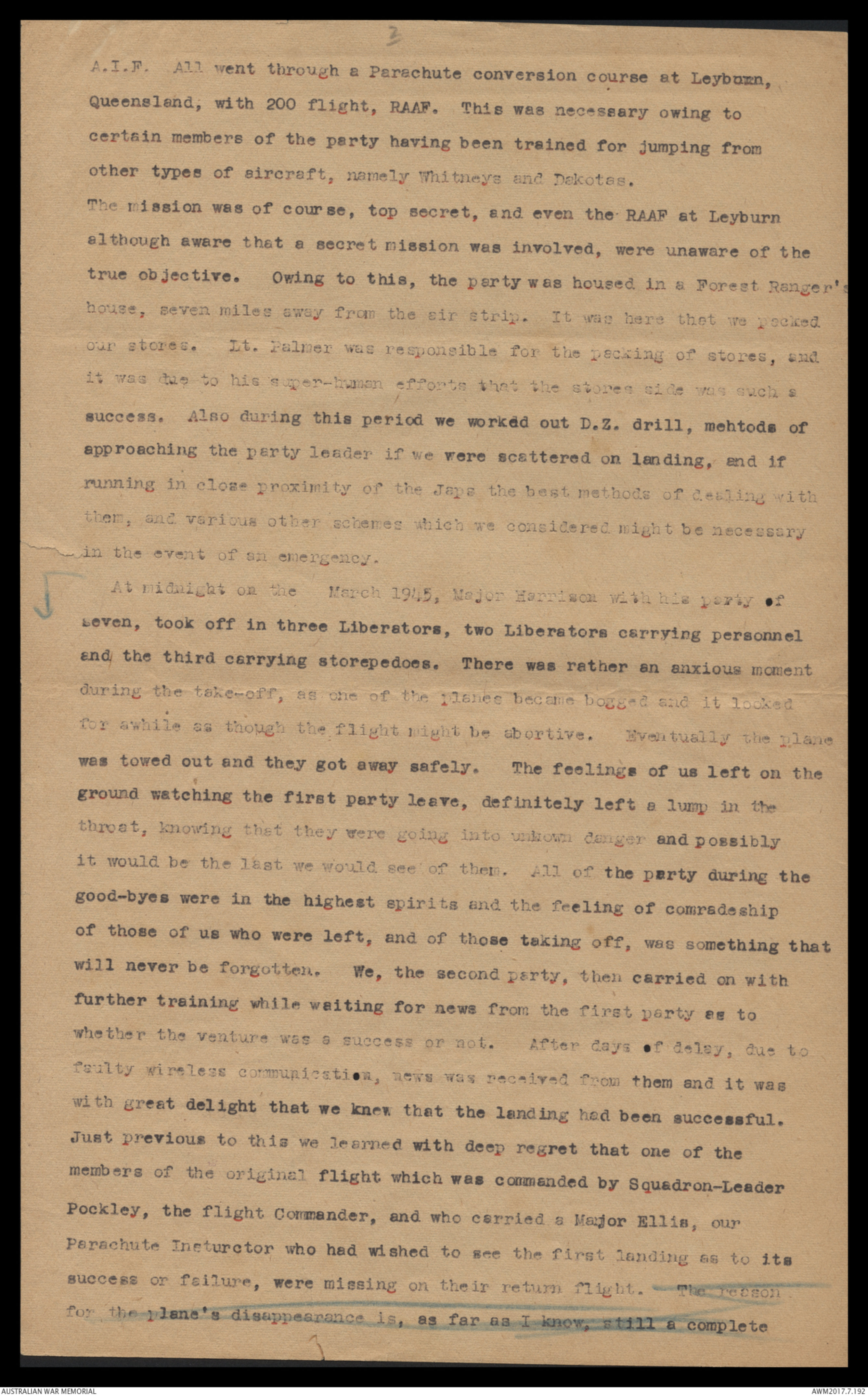
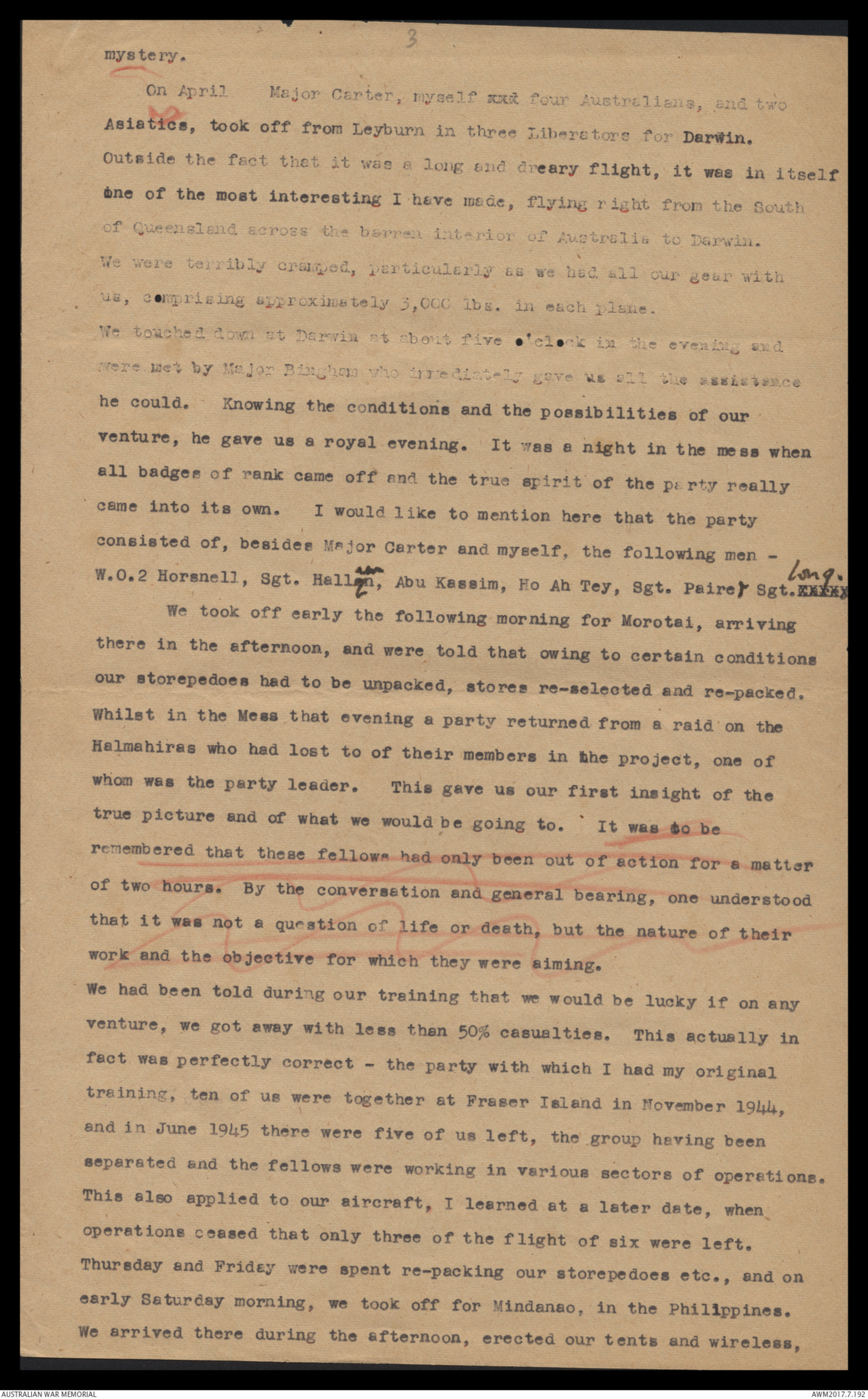
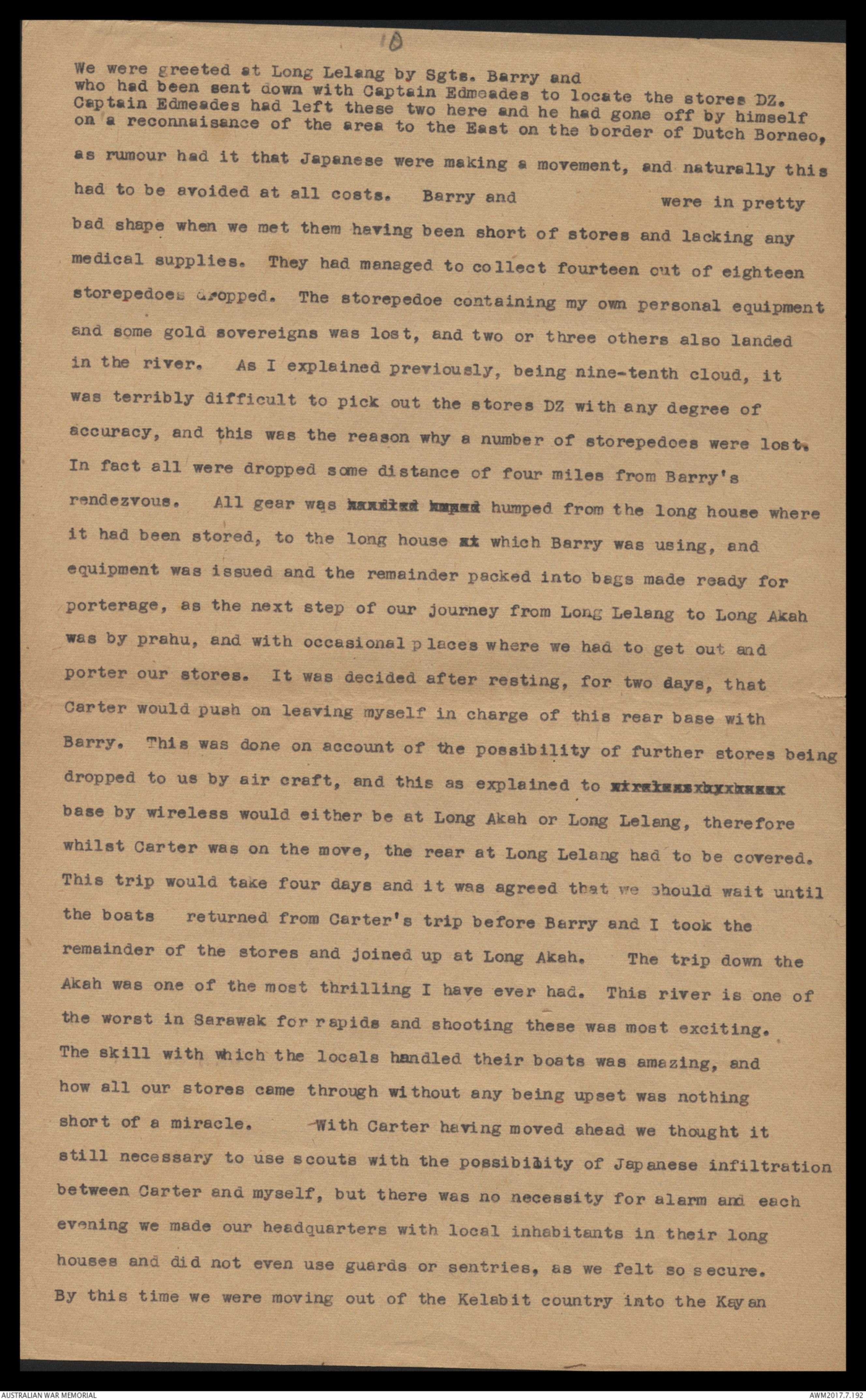
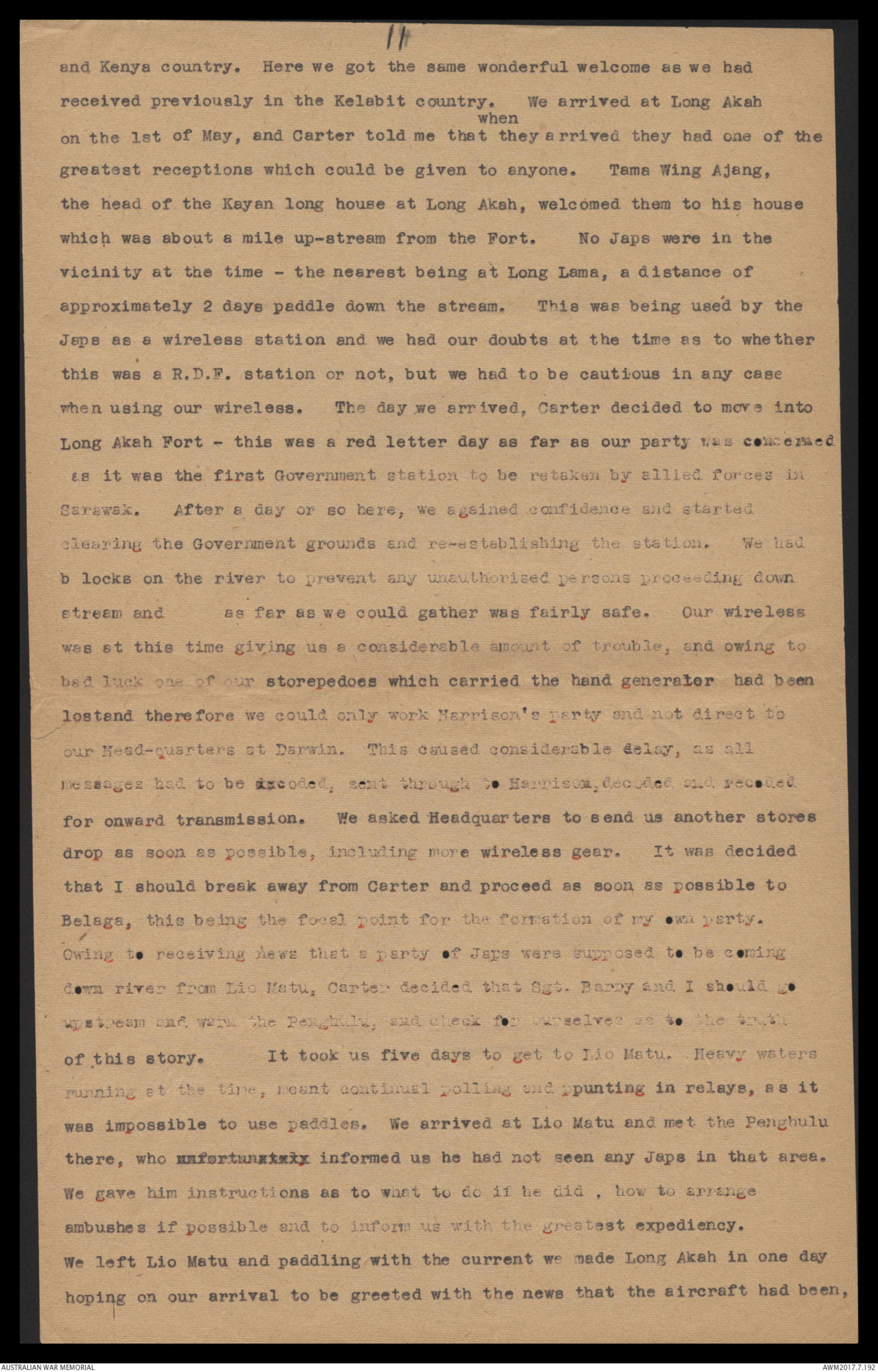
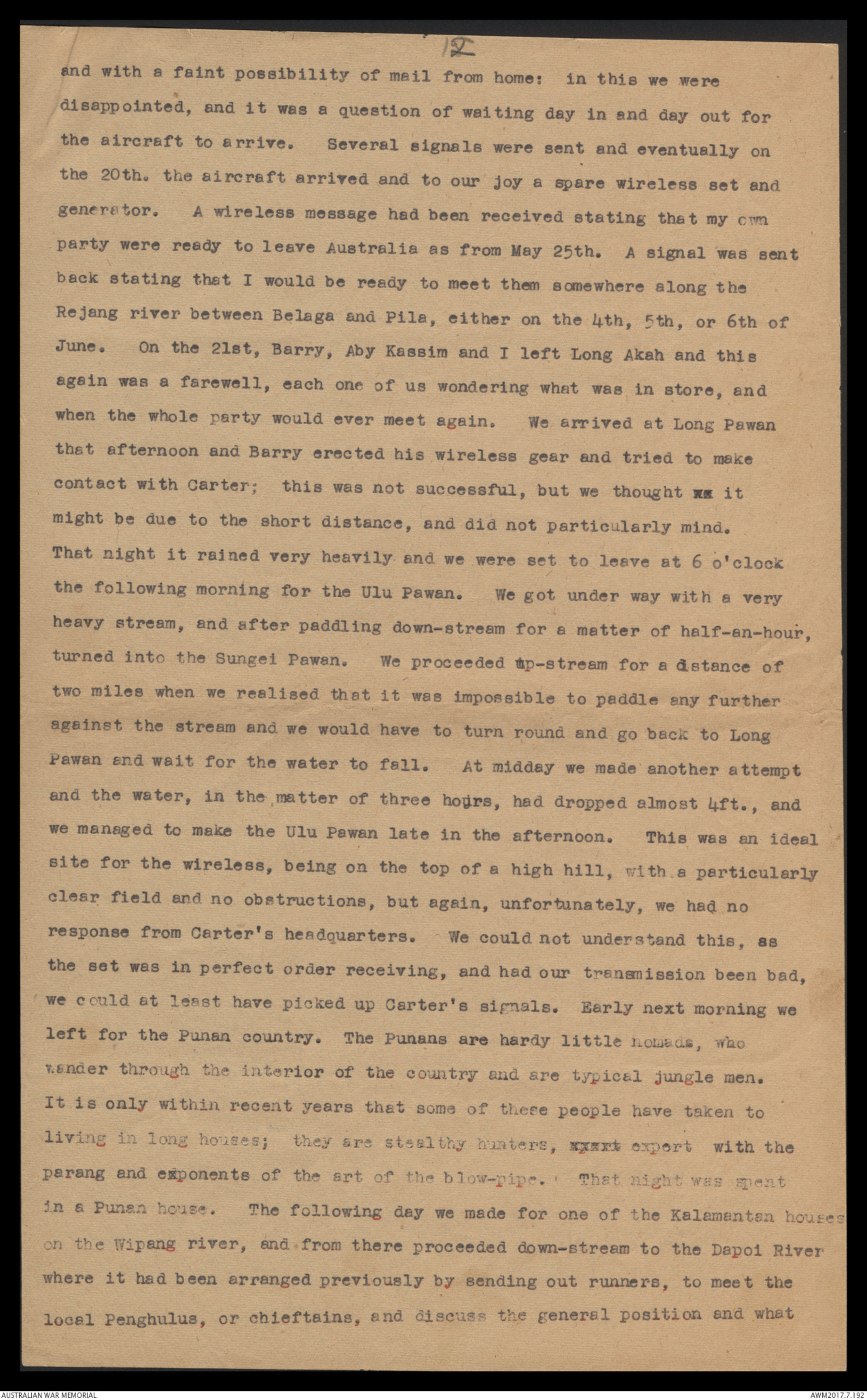
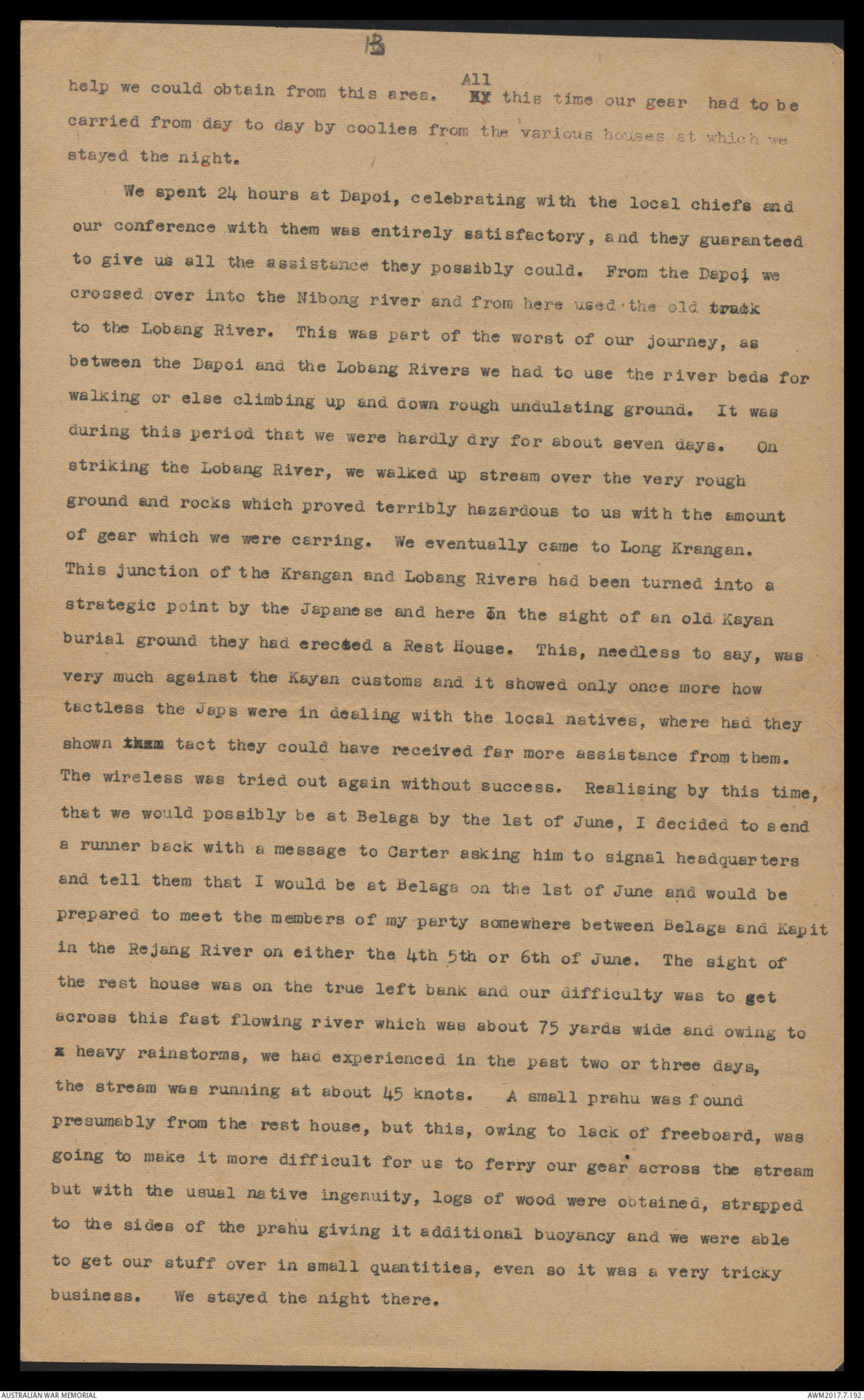
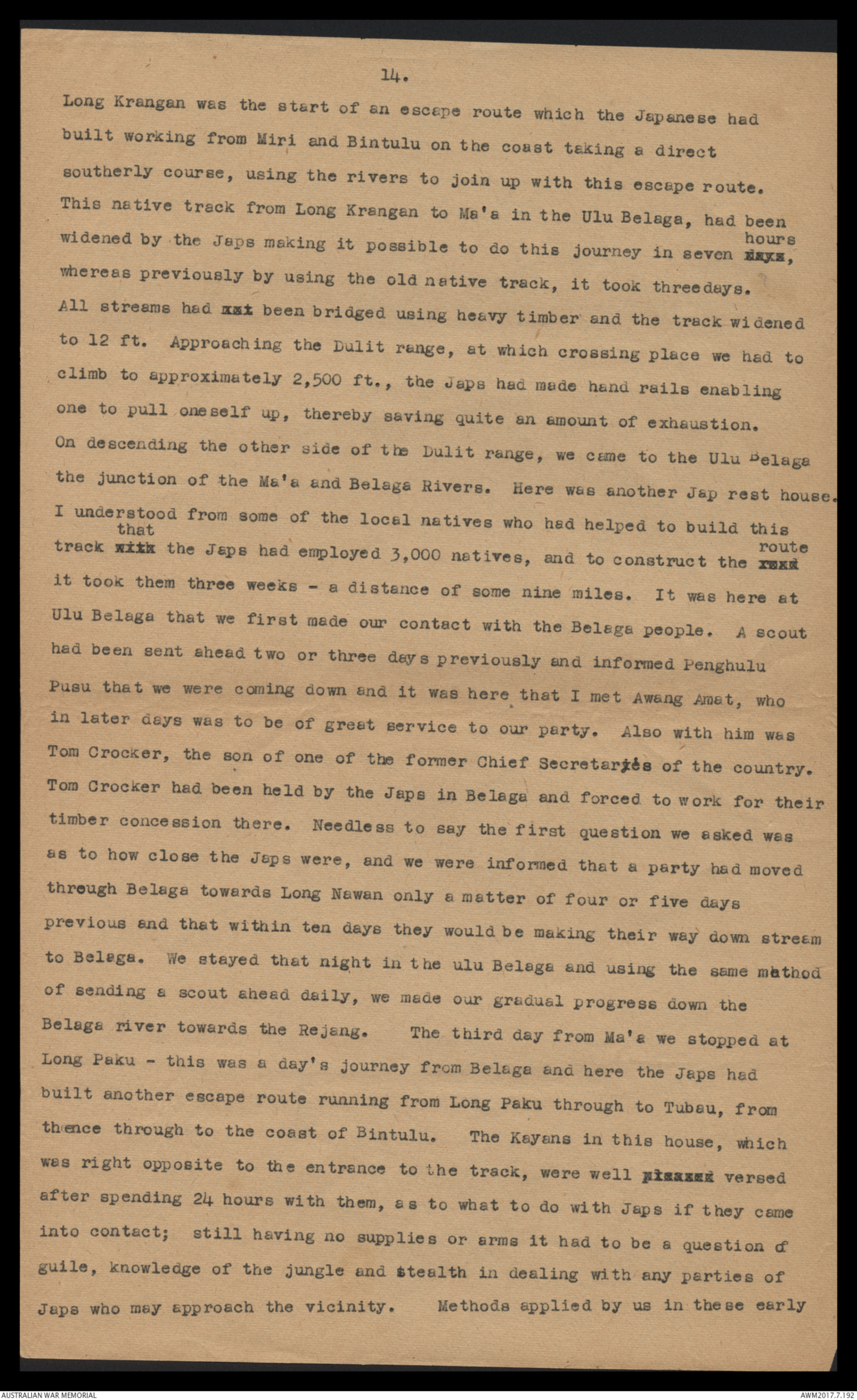
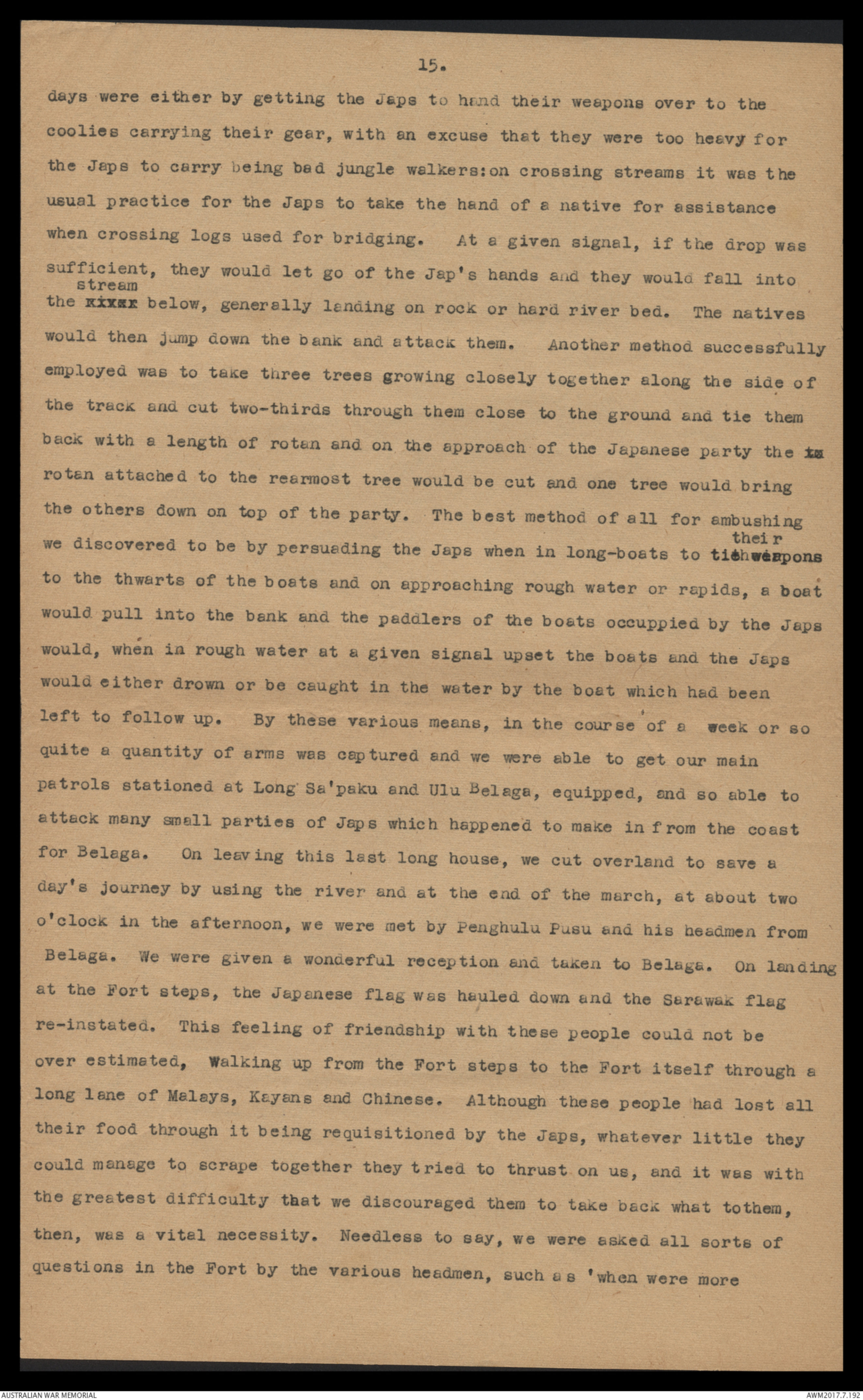
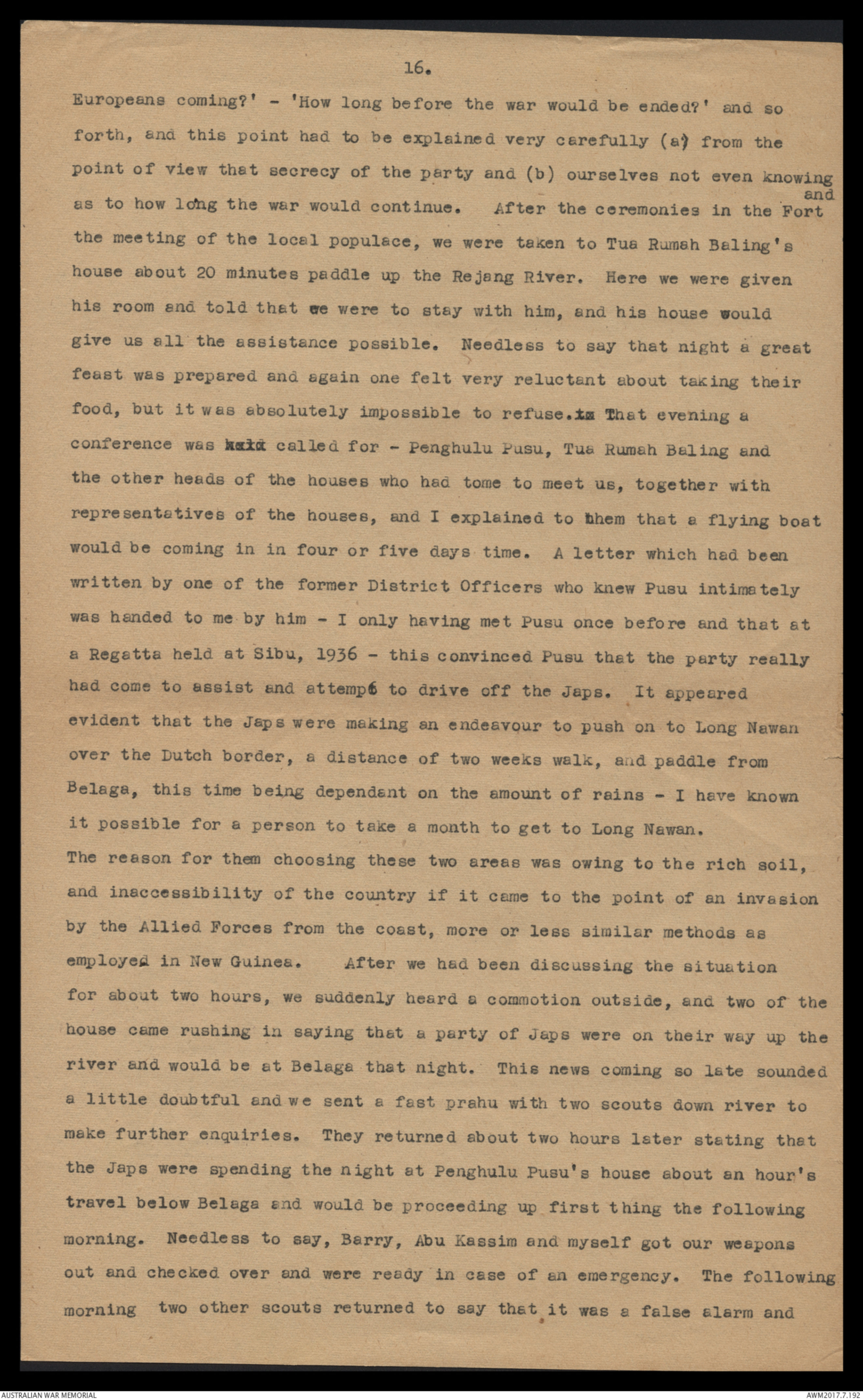
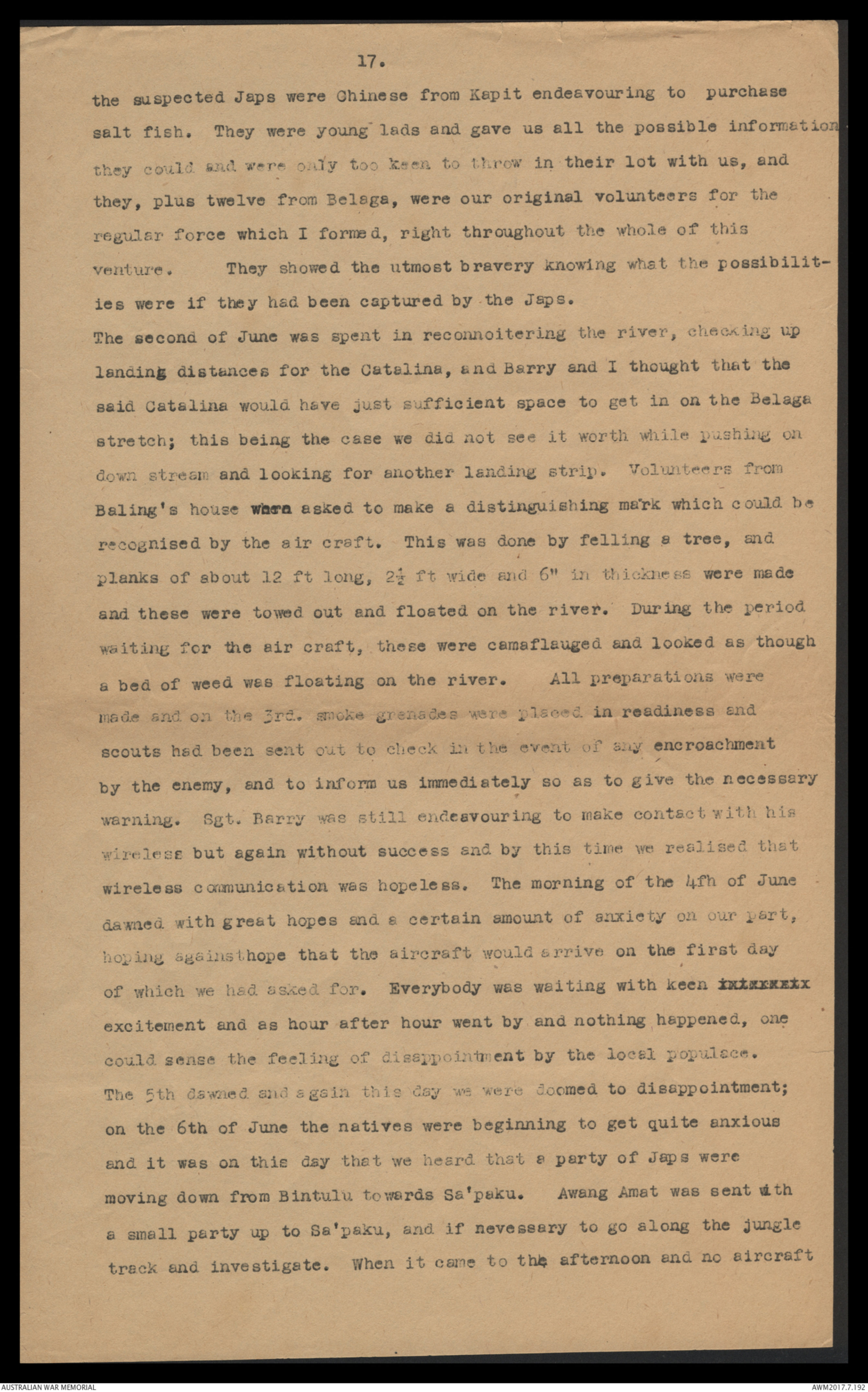
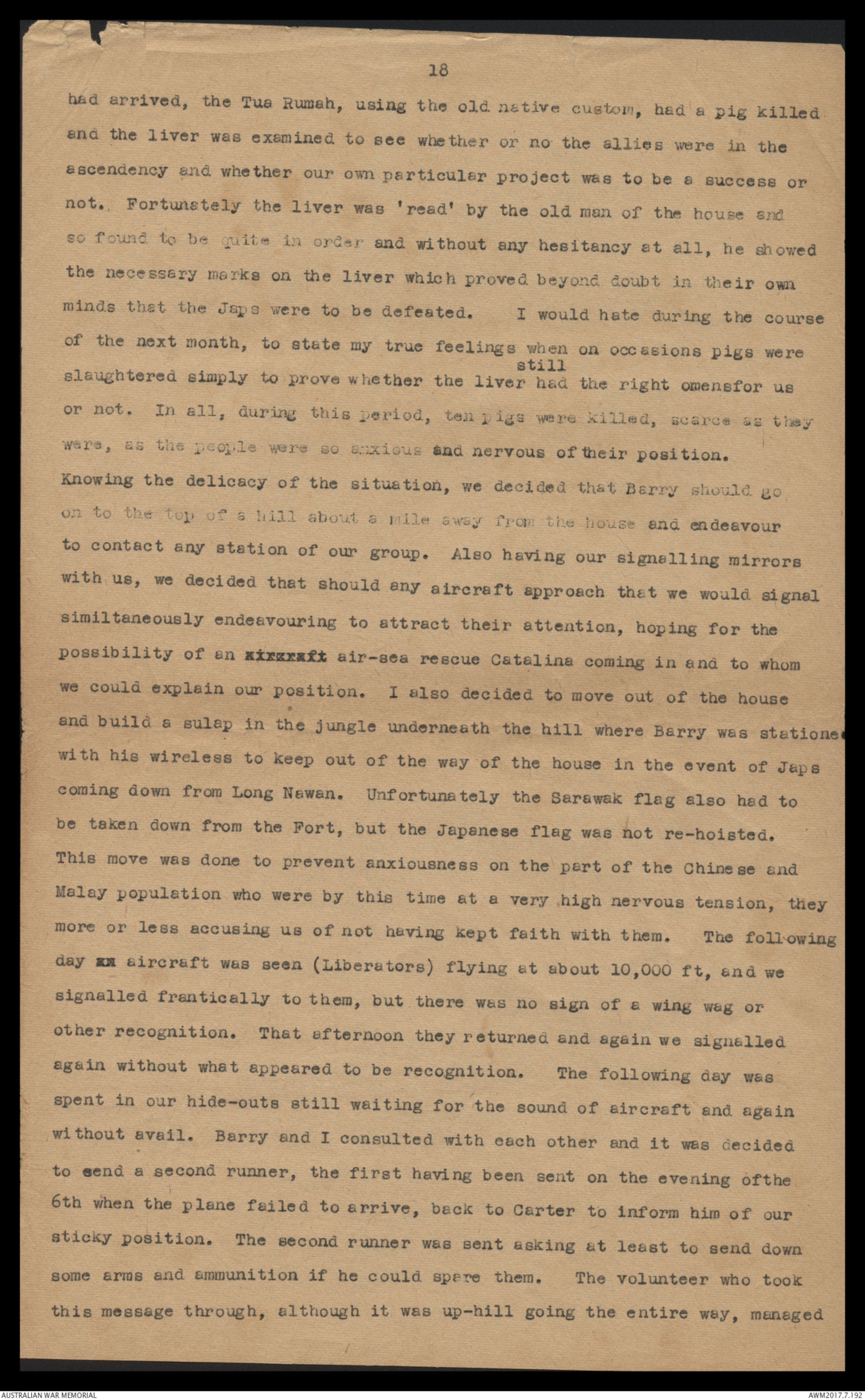
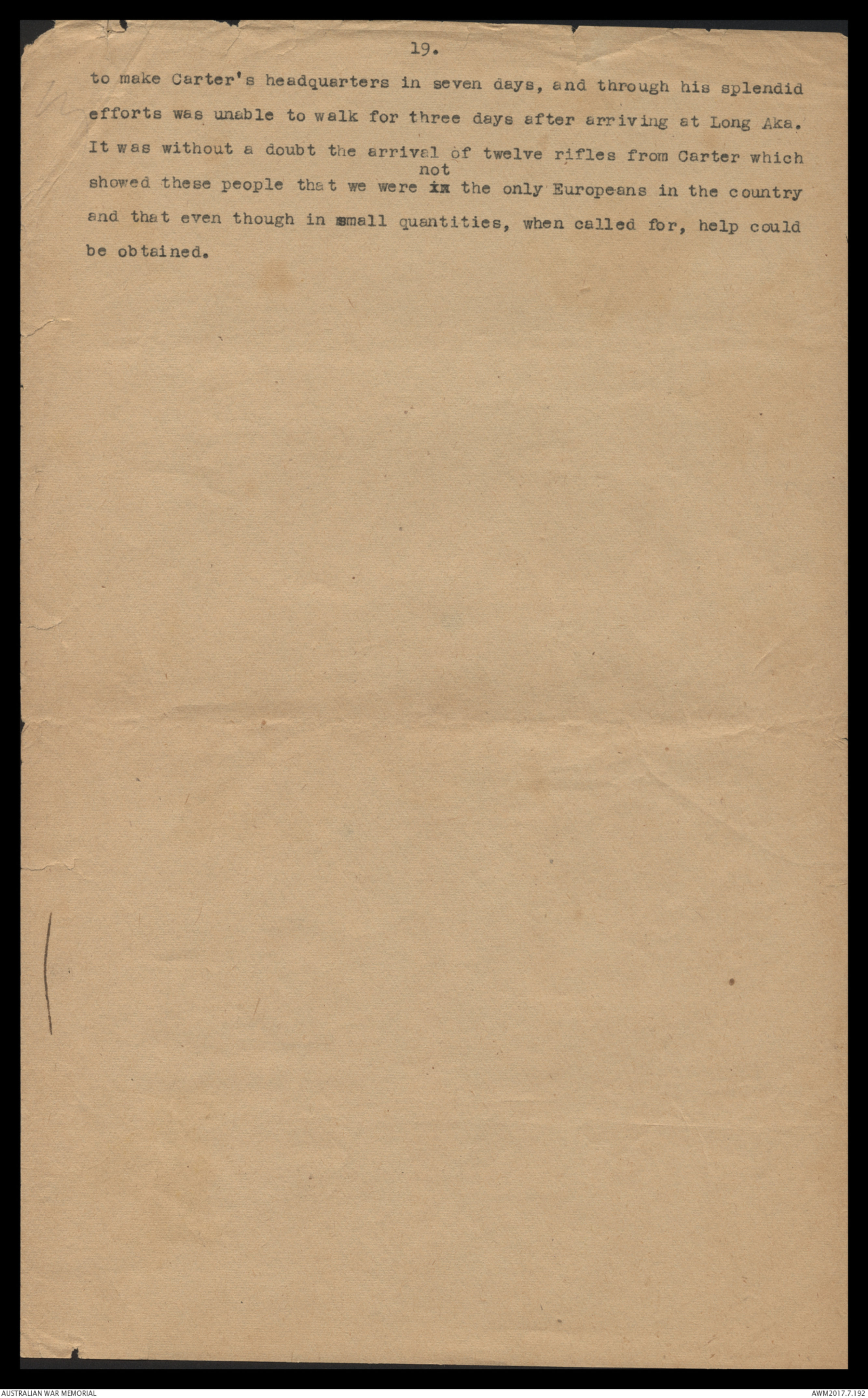
1
In London, April 1942, I met Lieut-Colonel D.L. Leach of the Sarawak
Government, who was then serving in the Royal Engineers, and we discussed
the position of Sarawak in view of the Japanese invssion, and both of
us having so many friends among the people of the country, realised that
something had to be done for them seeing their drastic position.
We formed a plan whereby we intended to obtain an unserviceable Sunderlend
flying boat, and with a volunteer crew of seventeen, fly from Australia
to make a londing on a strip of the Batang Rejang which was dead straight
for approximately three miles, known as Nanga Pila. The crew would
consist of volunteer personnel, including a Doctor, two wireless operators,
and sufficient people to man the flying boat, in addition to our own
volunteers. This scheme was put forward by me to Colonel Parke-Smith
of Combined. Operations, who unfortunately was killed later at Dieppe.
Owing possibly to this unfortunate occurrence, I did not hear any further
from Combined Operations. After several months of waiting, during the
course of conversation, I heard that Captain Madden, R.N., whom I knew
from days when I was stationed at Portland, was Naval Assistant to xxx the
second Sea Lord. I wrote to him with a possibility of an interview and
to ask him whether he could offer me any assistance with Combined Operations
with a view to the Sarawak Operation. After a few weeks, contact was made
with S.O.E. (Subversive Operations Europe) and I reported for an
interview. Eventually my services were called for, but owing to the
shortage of personnel in the Prison Service, The Prisons Commission stated
that I could not be released. After several months of further insistence
on my part I was seconded from the Prison Commission to the Army for
subversive work. I was transferred to S.O.E. in May 1944 and after
commando training in the West of Scotland, Parachute training outside
Manchester, and attending various schools for subversive operations, I
received orders to proceed to Australia. There further training was
necessary for S.R.D. operations - S.R.D. being the name given to the
Services Reconnaisance Dept. Plans were put forward for the Sarawak
view, cancelled, and then re-planned, this causing a delay from September
1944 to March 1945. Due to this delay, a further toughening-up course
was necessary at Fraser Island, Queensland, for the party of sixteen who
were selected for the Sarawak programme. With the exception of Major
Harrison, Major Carter and myself, all were Australians from Z Unit of the
2
A.I.F. All went through a Parachute conversion course at Leyburn,
Queensland, with 200 flight, RAAF. This was necessary owing to
certain members of the party having been trained for jumping from
other types of aircraft, namely Whitneys and Dakotas.
The mission was of course, top secret, and even the RAAF at Leyburn
although aware that a secret mission was involved, were unaware of the
true objective. Owing to this, the party was housed in a Forest Ranger's
house, seven miles away from the air strip. It was here that we packed
our stores. Lt. Palmer was responsible for the packing of stores, and
it was due to his super-human efforts that the stores side was such a
success. Also during this period we worked out D.Z. drill, mehtods of
approaching the party leader if we were scattered on landing, and if
running in close proximity of the Japs the best methods of dealing with
them, and various other schemes which we considered might be necessary
in the event of an emergency.
At midnight on the March 1955, Major Harrison with his party of
seven, took off in three Liberators, two Liberators carrying personnel
and the third carrying storepedoes. There was rather an anxious moment
during the take-off, as one of the planes became bogged and it looked
for awhile as though the flight might be abortive. Eventually the plane
was towed out and they got away safely. The feelings of us left on the
ground watching the first party leave, definitely left a lump in the
throat, knowing that they were going into unknown danger and possibly
it would be the last we would see of them. All of the party during the
good-byes were in the highest spirits and the feeling of comradeship
of those of us who were left, and of those taking off, was something that
will never be forgotten. We, the second party, then carried on with
further training while waiting for news from the first party as to
whether the venture was a success or not. After days of delay, due to
faulty wireless communication, news was received from them and it was
with great delight that we knew that the landing had been successful.
Just previous to this we learned with deep regret that one of the
members of the original flight which was commanded by Squadron-Leader
Pockley, the flight Commander, and who carried a Major Ellis, our
Parachute Insturctor who had wished to see the first landing as to its
success or failure, were missing on their return flight. The reasonfor the plane's disappearance is, as far as I know, still a complete
3
mystery.
On April Major Carter, myself xxx four Australians, and two
Asiatics, took off from Leyburn in three Liberators for Darwin.
Outside the fact that it was a long and dreary flight, it was in itself
one of the most interesting I have made, flying right from the South
of Queensland across the barren interior of Australia to Darwin.
We were terribly cramped, particularly as we had all our gear with
us, comprising approximately 3,000 lbs. in each plane.
We touched down at Darwin at about five o'clock in the evening and
were met by Major Bingham who immediately gave us all the assistance
he could. Knowing the conditions and the possibilities of our
venture, he gave us a royal evening. It was a night in the mess when
all badges of rank came off and the true spirit of the party really
came into its own. I would like to mention here that the party
consisted of, besides Major Carter and myself, the following men -
W.O.2 Horsnell, Sgt. Hallam, Abu Kassim, Ho Ah Tey, Sgt. Paire & Sgt. xxxx Long.
We took off early the following morning for Morotai, arriving
there in the afternoon, and were told that owing to certain conditions
our storepedoes had to be unpacked, stores re-selected and re-packed.
Whilst in the Mess that evening a party returned from a raid on the
Halmahiras who had lost to of their members in the project, one of
whom was the party leader. This gave us our first insight of the
true picture and of what we would be going to. It was to beremembered that these fellows had only been out of action for a matterof two hours. By the conversation and general bearing, one understoodthat it was not a question of life or death, but the nature of theirwork and the objective for which they were aiming.
We had been told during our training that we would be lucky if on any
venture, we got away with less than 50% casualties. This actually in
fact was perfectly correct - the party with which I had my original
training, ten of us were together at Fraser Island in November 1944,
and in June 1945 there were five of us left, the group having been
separated and the fellows were working in various sectors of operations.
This also applied to our aircraft, I learned at a later date, when
operations ceased that only three of the flight of six were left.
Thursday and Friday were spent re-packing our storepedoes etc., and on
early Saturday morning, we took off for Mindanao, in the Philippines.
We arrived there during the afternoon, erected our tents and wireless,
10
We were greeted at Long Lelang by Sgts. Barry and
who had been sent down with Captain Edmeades to locate the stores DZ.
Captain Edmeades had left these two here and he had gone off by himself
on a reconnaisance of the area to the East on the border of Dutch Borneo,
as rumour had it that Japanese were making a movement, and naturally this
had to be avoided at all costs. Barry and were in pretty
bad shape when we met them having been short of stores and lacking any
medical supplies. They had managed to collect fourteen out of eighteen
storepedoes dropped. The storepedoe containing my own personal equipment
and some gold sovereigns was lost, and two or three others also landed
in the river. As I explained previously, being nine-tenth cloud, it
was terribly difficult to pick out the stores DZ with any degree of
accuracy, and this was the reason why a number of storepedoes were lost.
In fact all were dropped some distance of four miles from Barry's
rendezvous. All gear was xxxxx xxxxx humped from the long house where
it had been stored, to the long house xx which Barry was using, and
equipment was issued and the remainder packed into bags made ready for
porterage, as the next step of our journey from Long Lelang to Long Akah
was by prahu, and with occasional places where we had to get out and
porter our stores. It was decided after resting, for two days, that
Carter would push on leaving myself in charge of this rear base with
Barry. This was done on account of the possibility of further stores being
dropped to us by air craft, and this as explained to xxxxxxxxxxxxxxxxx
base by wireless would either be at Long Akah or Long Lelang, therefore
whilst Carter was on the move, the rear at Long Lelang had to be covered.
This trip would take four days and it was agreed that we should wait until
the boats returned from Carter's trip before Barry and I took the
remainder of the stores and joined up at Long Akah. The trip down the
Akah was one of the most thrilling I have ever had. This river is one of
the worst in Sarawak for rapids and shooting these was most exciting.
The skill with which the locals handled their boats was amazing, and
how all our stores came through without any being upset was nothing
short of a miracle. With Carter having moved ahead we thought it
still necessary to use scouts with the possibility of Japanese infiltration
between Carter and myself, but there was no necessity for alarm and each
evening we made our headquarters with local inhabitants in their long
houses and did not even use guards or sentries, as we felt so secure.
By this time we were moving out of the Kelabit country into the Kayan
11
and Kenya country. Here we got the same wonderful welcome as we had
received previously in the Kelabit country. We arrived at Long Akah
on the lst of May, and Carter told me that when they arrived they had one of the
greatest receptions which could be given to anyone. Tama Wing Ajang,
the head of the Kayan long house at Long Akah, welcomed them to his house
which was about a mile up-stream from the Fort. No Japs were in the
vicinity at the time - the nearest being at Long Lama, a distance of
approximately 2 days paddle down the stream. This was being used by the
Japs as a wireless station and we had our doubts at the time as to whether
this was a R.D.F. station or not, but we had to be cautious in any case
when using our wireless. The day we arrived, Carter decided to move into
Long Akah Fort - this was a red letter day as far as our party was concerned
as it was the first Government station to be retaken by allied forces in
Sarawak. After a day or so here, we agained confidence and started
clearing the Government grounds and re-establishing the station. We had
b locks on the river to prevent any unauthorised persons proceeding down
stream and as far as we could gather was fairly safe. Our wireless
was at this time giving us a considerable amount of trouble, and owing to
bad luck one of our storepedoes which carried the hand generator had been
lostand therefore we could only work Harrison's party and not direct to
our Head-quarters at Darwin. This caused considerable delay, as all
messages had to be xxcoded, sent through to Harrison, decoded and recoded
for onward transmission. We asked Headquarters to send us another stores
drop as soon as possible, including more wireless gear. It was decided
that I should break away from Carter and proceed as soon as possible to
Belaga, this being the focal point for the formation of my own party.
Owing to receiving news that a party of Japs were supposed to be coming
down river from Lio Matu, Carter decided that Sgt. Barry and I should go
upstream and warn the Penghulu, and check for ourselves as to the truth
of this story. It took us five days to get to Lio Matu. Heavy waters
running at the time, meant continual polling and ppunting in relays, as it
was impossible to use paddles. We arrived at Lio Matu and met the Penghulu
there, who unfortunately informed us he had not seen any Japs in that area.
We gave him instructions as to what to do if he did, how to arrange
ambushe s if possible and to inform us with the greatest expediency.
We left Lio Matu and paddling with the current we made Long Akah in one day
hoping on our arrival to be greeted with the news that the aircraft had been,
12
and with a faint possibility of mail from home: in this we were
disappointed, and it was a question of waiting day in and day out for
the aircraft to arrive. Several signals were sent and eventually on
the 20th. the aircraft arrived and to our joy a spare wireless set and
generator. A wireless message had been received stating that my own
party were ready to leave Australia as from May 25th. A signal was sent
back stating that I would be ready to meet them somewhere along the
Rejang river between Belaga and Pila, either on the 4th, 5th, or 6th of
June. On the 21st, Barry, Aby Kassim and I left Long Akah and this
again was a farewell, each one of us wondering what was in store, and
when the whole party would ever meet again. We arrived at Long Pawan
that afternoon and Barry erected his wireless gear and tried to make
contact with Carter; this was not successful, but we thought xx it
might be due to the short distance, and did not particularly mind.
That night it rained very heavily and we were set to leave at 6 o'clock
the following morning for the Ulu Pawan. We got under way with a very
heavy stream, and after paddling down-stream for a matter of half-an-hour,
turned into the Sungei Pawan. We proceeded up-stream for a dstance of
two miles when we realised that it was impossible to paddle any further
against the stream and we would have to turn round and go back to Long
Pawan and wait for the water to fall. At midday we made another attempt
and the water, in the matter of three hours, had dropped almost 4ft., and
we managed to make the Ulu Pawan late in the afternoon. This was an ideal
site for the wireless, being on the top of a high hill, with a particularly
clear field and no obstructions, but again, unfortunately, we had no
response from Carter's headquarters. We could not understand this, as
the set was in perfect order receiving, and had our transmission been bad,
we could at least have picked up Carter's signals. Early next morning we
left for the Punan country. The Punans are hardy little nomads, who
wander through the interior of the country and are typical jungle men.
It is only within recent years that some of these people have taken to
living in long houses; they are stealthy hunters, xxxxt expert with the
parang and exponents of the art of the blow-pipe. That night was spent
in a Punan house. The following day we made for one of the Kalamantan house
on the Wipang river, and from there proceeded down-stream to the Dapoi River
where it had been arranged previously by sending out runners, to meet the
local Penghulus, or chieftains, and discuss the general position and what
13
help we could obtain from this area. XX All this time our gear had to be
carried from day to day by coolies from the various houses at which we
stayed the night.
We spent 24 hours at Dapoi, celebrating with the local chiefs and
our conference with them was entirely satisfactory, and they guaranteed
to give us all the assistance they possibly could. From the Dapoi we
crossed over into the Nibong river and from here used the old track
to the Lobang River. This was part of the worst of our journey, as
between the Dapoi and the Lobang Rivers we had to use the river beds for
walking or else climbing up and down rough undulating ground. It was
during this period that we were hardly dry for about seven days. On
striking the Lobang River, we walked up stream over the very rough
ground and rocks which proved terribly hazardous to us with the amount
of gear which we were carring. We eventually came to Long Krangan.
This junction of the Krangan and Lobang Rivers had been turned into a
strategic point by the Japanese and here on the sight of an old Kayan
burial ground they had erected a Rest House. This, needless to say, was
very much against the Kayan customs and it showed only once more how
tactless the Japs were in dealing with the local natives, where had they
shown them tact they could have received far more assistance from them.
The wireless was tried out again without success. Realising by this time,
that we would possibly be at Belaga by the 1st of June, I decided to send
a runner back with a message to Carter asking him to signal headquarters
and tell them that I would be at Belaga on the 1st of June and would be
prepared to meet the members of my party somewhere between Belaga and Kapit
in the Rejang River on either the 4th 5th or 6th of June. The sight of
the rest house was on the true left bank and our difficulty was to get
across this fast flowing river which was about 75 yards wide and owing tox heavy rainstorms, we had experienced in the past two or three days,
the stream was running at about 45 knots. A small prahu was found
presumably from the rest house, but this, owing to lack of freeboard, was
going to make it more difficult for us to ferry our gear across the stream
but with the usual native ingenuity, logs of wood were obtained, strapped
to the sides of the prahu giving it additional buoyancy and we were able
to get our stuff over in small quantities, even so it was a very tricky
business. We stayed the night there.
14.
Long Krangan was the start of an escape route which the Japanese had
built working from Miri and Bintulu on the coast taking a direct
southerly course, using the rivers to join up with this escape route.
This native track from Long Krangan to Ma'a in the Ulu Belaga, had been
widened by the Japs making it possible to do this journey in seven days hours
whereas previously by using the old native track, it took three days.
All streams had xxx been bridged using heavy timber and the track widened
to 12 ft. Approaching the Dulit range, at which crossing place we had to
climb to approximately 2,500 ft., the Japs had made hand rails enabling
one to pull oneself up, thereby saving quite an amount of exhaustion.
On descending the other side of the Dulit range, we came to the Ulu Belaga
the junction of the Ma'a and Belaga Rivers. Here was another Jap rest house.
I understood from some of the local natives who had helped to build this
track xxxx that the Japs had employed 3,000 natives, and to construct the xxxx route
it took them three weeks - a distance of some nine miles. It was here at
Ulu Belaga that we first made our contact with the Belaga people. A scout
had been sent ahead two or three days previously and informed Penghulu
Pusu that we were coming down and it was here that I met Awang Amat, who
in later days was to be of great service to our party. Also with him was
Tom Crocker, the son of one of the former Chief Secretaries of the country.
Tom Crocker had been held by the Japs in Belaga and forced to work for their
timber concession there. Needless to say the first question we asked was
as to how close the Japs were, and we were informed that a party had moved
through Belaga towards Long Nawan only a matter of four or five days
previous and that within ten days they would be making their way down stream
to Belaga. We stayed that night in the ulu Belaga and using the same method
of sending a scout ahead daily, we made our gradual progress down the
Belaga river towards the Rejang. The third day from Ma'a we stopped at
Long Paku - this was a day's journey from Belaga and here the Japs had
built another escape route running from Long Paku through to Tubau, from
thence through to the coast of Bintulu. The Kayans in this house, which
was right opposite to the entrance to the track, were well xxxxxxx versed
after spending 24 hours with them, as to what to do with Japs if they came
into contact; still having no supplies or arms it had to be a question of
guile, knowledge of the jungle and stealth in dealing with any parties of
Japs who may approach the vicinity. Methods applied by us in these early
15.
days were either by getting the Japs to hand their weapons over to the
coolies carrying their gear, with an excuse that they were too heavy for
the Japs to carry being bad jungle walkers:on crossing streams it was the
usual practice for the Japs to take the hand of a native for assistance
when crossing logs used for bridging. At a given signal, if the drop was
sufficient, they would let go of the Jap's hands and they would fall into
the river stream below, generally landing on rock or hard river bed. The natives
would then jump down the bank and attack them. Another method successfully
employed was to take three trees growing closely together along the side of
the track and cut two-thirds through them close to the ground and tie them
back with a length of rotan and on the approach of the Japanese party the xx
rotan attached to the rearmost tree would be cut and one tree would bring
the others down on top of the party. The best method of all for ambushing
we discovered to be by persuading the Japs when in long-boats to tie their weapons
to the thwarts of the boats and on approaching rough water or rapids, a boat
would pull into the bank and the paddlers of the boats occuppied by the Japs
would, when in rough water at a given signal upset the boats and the Japs
would either drown or be caught in the water by the boat which had been
left to follow up. By these various means, in the course of a week or so
quite a quantity of arms was captured and we were able to get our main
patrols stationed at Long Sa'paku and Ulu Belaga, equipped, and so able to
attack many small parties of Japs which happened to make in from the coast
for Belaga. On leaving this last long house, we cut overland to save a
day's journey by using the river and at the end of the march, at about two
o'clock in the afternoon, we were met by Penghulu Pusu and his headmen from
Belaga. We were given a wonderful reception and taken to Belaga. On landing
at the Fort steps, the Japanese flag was hauled down and the Sarawak flag
re-instated. This feeling of friendship with these people could not be
over estimated, Walking up from the Fort steps to the Fort itself through a
long lane of Malays, Kayans and Chinese. Although these people had lost all
their food through it being requisitioned by the Japs, whatever little they
could manage to scrape together they tried to thrust on us, and it was with
the greatest difficulty that we discouraged them to take back what tothem,
then, was a vital necessity. Needless to say, we were asked all sorts of
questions in the Fort by the various headmen, such as 'when were more
16.
Europeans coming?' - 'How long before the war would be ended?' and so
forth, and this point had to be explained very carefully (a) from the
point of view that secrecy of the party and (b) ourselves not even knowing
as to how long the war would continue. After the ceremonies in the Fort and
the meeting of the local populace, we were taken to Tua Rumah Baling's
house about 20 minutes paddle up the Rejang River. Here we were given
his room and told that we were to stay with him, and his house would
give us all the assistance possible. Needless to say that night a great
feast was prepared and again one felt very reluctant about taking their
food, but it was absolutely impossible to refuse.xx That evening a
conference was xxxx called for - Penghulu Pusu, Tua Rumah Baling and
the other heads of the houses who had tome to meet us, together with
representatives of the houses, and I explained to them that a flying boat
would be coming in in four or five days time. A letter which had been
written by one of the former District Officers who knew Pusu intimately
was handed to me by him - I only having met Pusu once before and that at
a Regatta held at Sibu, 1936 - this convinced Pusu that the party really
had come to assist and attempt to drive off the Japs. It appeared
evident that the Japs were making an endeavour to push on to Long Nawan
over the Dutch border, a distance of two weeks walk, and paddle from
Belaga, this time being dependant on the amount of rains - I have known
it possible for a person to take a month to get to Long Nawan.
The reason for them choosing these two areas was owing to the rich soil,
and inaccessibility of the country if it came to the point of an invasion
by the Allied Forces from the coast, more or less similar methods as
employed in New Guinea. After we had been discussing the situation
for about two hours, we suddenly heard a commotion outside, and two of the
house came rushing in saying that a party of Japs were on their way up the
river and would be at Belaga that night. This news coming so late sounded
a little doubtful and we sent a fast prahu with two scouts down river to
make further enquiries. They returned about two hours later stating that
the Japs were spending the night at Penghulu Pusu's house about an hour's
travel below Belaga and would be proceeding up first thing the following
morning. Needless to say, Barry, Abu Kassim and myself got our weapons
out and checked over and were ready in case of an emergency. The following
morning two other scouts returned to say that, it was a false alarm and
17.
the suspected Japs were Chinese from Kapit endeavouring to purchase
salt fish. They were young lads and gave us all the possible information
they could and were only too keen to throw in their lot with us, and
they, plus twelve from Belaga, were our original volunteers for the
regular force which I formed, right throughout the whole of this
venture. They showed the utmost bravery knowing what the possibilit-
ies were if they had been captured by the Japs.
The second of June was spent in reconnoitering the river, checking up
landing distances for the Catalina, and Barry and I thought that the
said Catalina would have just sufficient space to get in on the Belaga
stretch; this being the case we did not see it worth while pushing on
down stream and looking for another landing strip. Volunteers from
Baling's house were asked to make a distinguishing mark which could be
recognised by the air craft. This was done by felling a tree, and
planks of about 12 ft long, 2 ½ ft wide and 6" in thickness were made
and these were towed out and floated on the river. During the period
waiting for the air craft, these were camaflauged and looked as though
a bed of weed was floating on the river. All preparations were
made and on the 3rd. smoke grenades were placed in readiness and
scouts had been sent out to check in the event of any encroachment
by the enemy, and to inform us immediately so as to give the necessary
warning. Sgt. Barry was still endeavouring to make contact with his
wireless but again without success and by this time we realised that
wireless communication was hopeless. The morning of the 4fh of June
dawned with great hopes and a certain amount of anxiety on our part,
hoping againsthope that the aircraft would arrive on the first day
of which we had asked for. Everybody was waiting with keen xxxxxxxx
excitement and as hour after hour went by and nothing happened, one
could sense the feeling of disappointment by the local populace.
The 5th dawned and again this day we were doomed to disappointment;
on the 6th of June the natives were beginning to get quite anxious
and it was on this day that we heard that a party of Japs were
moving down from Bintulu towards Sa'paku. Awang Amat was sent with
a small party up to Sa'paku, and if nevessary to go along the jungle
track and investigate. When it came to the afternoon and no aircraft
18
had arrived, the Tua Rumah, using the old native custom, had a pig killed
and the liver was examined to see whether or no the allies were in the
ascendency and whether our own particular project was to be a success or
not. Fortunately the liver was 'read' by the old man of the house and
so found to be quite in order and without any hesitancy at all, he showed
the necessary marks on the liver which proved beyond doubt in their own
minds that the Japs were to be defeated. I would hate during the course
of the next month, to state my true feelings when on occasions pigs were
slaughtered simply to prove whether the liver still had the right omensfor us
or not. In all, during this period, ten pigs were killed, scarce as they
were, as the people were so anxious and nervous of their position.
Knowing the delicacy of the situation, we decided that Barry should go
on to the top of a hill about a mile away from the house and endeavour
to contact any station of our group. Also having our signalling mirrors
with us, we decided that should any aircraft approach that we would signal
similtaneously endeavouring to attract their attention, hoping for the
possibility of an aircraft air-sea rescue Catalina coming in and to whom
we could explain our position. I also decided to move out of the house
and build a sulap in the jungle underneath the hill where Barry was stationed
with his wireless to keep out of the way of the house in the event of Japs
coming down from Long Nawan. Unfortunately the Sarawak flag also had to
be taken down from the Fort, but the Japanese flag was not re-hoisted.
This move was done to prevent anxiousness on the part of the Chinese and
Malay population who were by this time at a very high nervous tension, they
more or less accusing us of not having kept faith with them. The following
day an aircraft was seen (Liberators) flying at about 10,000 ft, and we
signalled frantically to them, but there was no sign of a wing wag or
other recognition. That afternoon they returned and again we signalled
again without what appeared to be recognition. The following day was
spent in our hide-outs still waiting for the sound of aircraft and again
without avail. Barry and I consulted with each other and it was decided
to send a second runner, the first having been sent on the evening ofthe
6th when the plane failed to arrive, back to Carter to inform him of our
sticky position. The second runner was sent asking at least to send down
some arms and ammunition if he could spare them. The volunteer who took
this message through, although it was up-hill going the entire way, managed
19.
to make Carter's headquarters in seven days, and through his splendid
efforts was unable to walk for three days after arriving at Long Aka.
It was without a doubt the arrival of twelve rifles from Carter which
showed these people that we were xx not the only Europeans in the country
and that even though in small quantities, when called for, help could
be obtained.
 Jacqueline Kennedy
Jacqueline KennedyThis transcription item is now locked to you for editing. To release the lock either Save your changes or Cancel.
This lock will be automatically released after 60 minutes of inactivity.